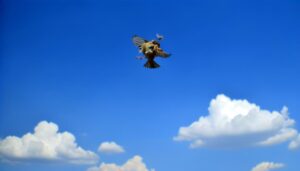Measuring How Fast a Sparrow Hawk Can Fly
Sparrow hawks (Accipiter nisus), known for their agility and precision, typically fly at speeds between 30 to 40 miles per hour. In level flight, they achieve velocities up to 31 mph, with their speed dramatically increasing to 50 mph during a dive to capture prey.
This rapid pace is facilitated by their broad and rounded wings, which enhance low-speed control, and long, narrow tails for improved steering. These aerodynamic characteristics enable sparrow hawks to execute swift, sudden attacks, showcasing their prowess as adept hunters.
For more insights into their flight dynamics and hunting techniques, fascinating details await.
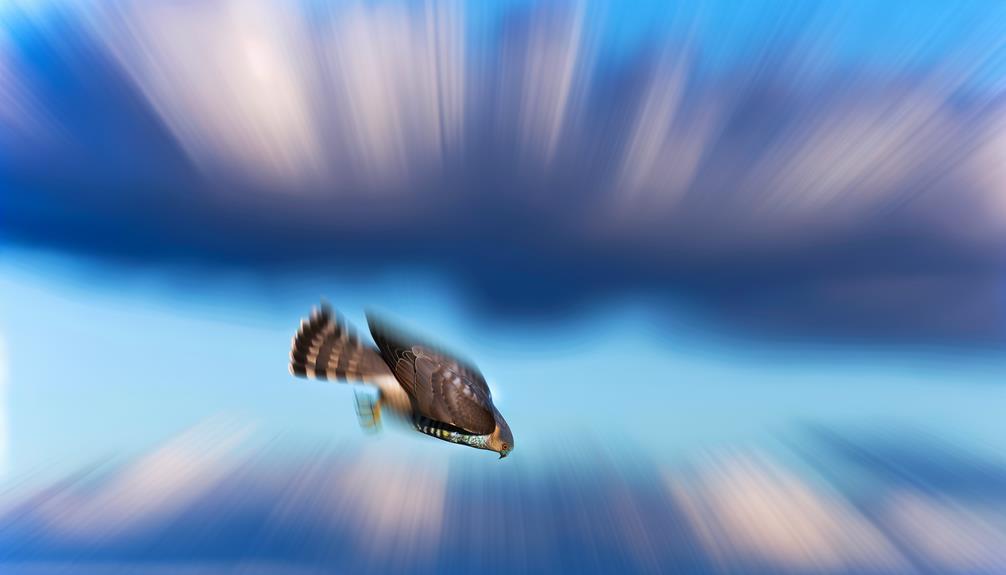
Key Takeaways
- Sparrow hawks reach speeds of 30 to 40 miles per hour in flight.
- In level flight, sparrow hawks can fly up to 31 miles per hour.
- Diving to capture prey, sparrow hawks can achieve speeds of up to 50 miles per hour.
- Wind patterns and thermal currents significantly influence sparrow hawk flying speed.
- Accurate speed measurements use radar tracking, GPS telemetry, and high-speed photography.
Sparrow Hawk Speed
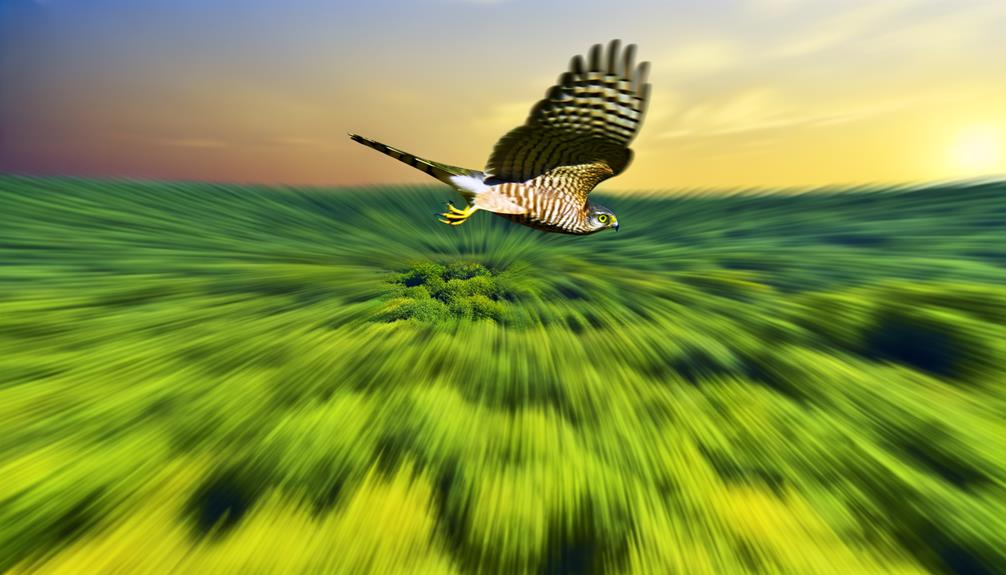
The flight speed of the sparrow hawk (Accipiter nisus) has been carefully documented, revealing that these raptors can achieve velocities ranging from 30 to 40 miles per hour during level flight. This speed range is supported by empirical observations and radar tracking data collected from various studies.
These medium-sized birds of prey utilize their speed for efficient hunting, primarily targeting small birds and mammals. Their streamlined bodies and powerful wings contribute importantly to their swift flight capabilities. Moreover, their speed plays a vital role in their predatory success, allowing them to execute rapid pursuits and agile maneuvers.
This velocity also aids in migration, enabling sparrow hawks to traverse notable distances with relative ease and energy efficiency.
Flight Characteristics
In addition to their impressive speed, sparrow hawks exhibit a range of flight characteristics that enhance their hunting efficiency and adaptability to diverse environments. These raptors demonstrate exceptional maneuverability, allowing for rapid changes in direction and altitude. Their flight involves a combination of rapid wing beats and gliding, facilitating energy-efficient movement. The table below outlines key flight characteristics:
| Characteristic | Description |
|---|---|
| Wing Loading | Low, enabling agile flight and tight turns |
| Flight Style | Mix of flapping and gliding |
| Wing Shape | Broad and rounded, aiding in low-speed control |
| Tail Function | Long and narrow for improved steering |
| Hovering Ability | Limited but used for brief surveillance |
These traits are essential for maneuvering through dense habitats and capturing agile prey, emphasizing the sparrow hawk's evolutionary adaptations for survival.
Hunting Techniques
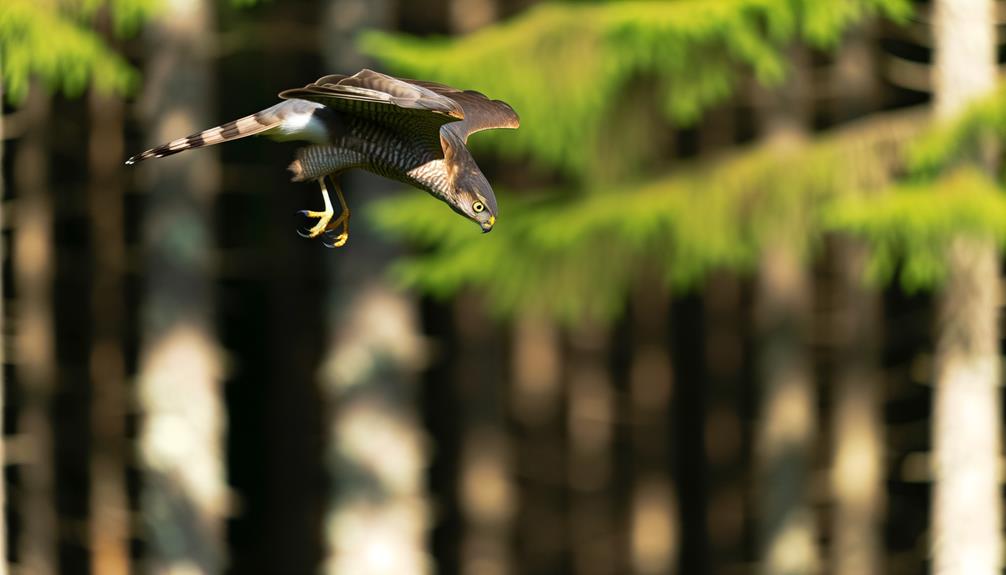
Utilizing a combination of stealth, speed, and precision, sparrow hawks employ a diverse array of hunting techniques tailored to their prey and environment. These birds of prey primarily engage in still-hunting from a concealed perch, where they scan for unsuspecting avian or small mammalian prey.
Upon sighting a target, they launch a sudden and rapid attack, minimizing reaction time for the prey. In open habitats, sparrow hawks may also use low, contour-hugging flight patterns to surprise their quarry. Additionally, they are known to employ aerial pursuits, leveraging their agility to outmaneuver prey mid-flight.
These varied methods underscore their adaptability and effectiveness as hunters, maximizing their success rates in capturing elusive prey.
Speed Comparison
While their hunting techniques demonstrate remarkable adaptability, evaluating the velocity of sparrow hawks in various contexts reveals their impressive capability for rapid acceleration and sustained flight.
Scientific observations indicate that sparrow hawks can reach speeds up to 50 kilometers per hour (31 mph) during level flight. When diving to capture prey, their velocity can increase significantly, approaching speeds of 80 kilometers per hour (50 mph).
Compared to other raptors, such as peregrine falcons, which can dive at speeds exceeding 320 kilometers per hour (200 mph), sparrow hawks exhibit moderate but highly effective speed. This swiftness enables them to maneuver through dense vegetation and urban environments, ensuring their proficiency as agile predators.
Therefore, speed comparison underscores their niche specialization and ecological versatility.
Influencing Factors

Several variables greatly influence the flight speed of sparrow hawks, including environmental conditions, prey availability, and anatomical adaptations. These factors interplay to determine the hawk's ability to navigate and hunt efficiently.
Key influencing elements include:
- Wind Patterns: Favorable winds can greatly enhance flying speed, while headwinds can impede it.
- Prey Density: High prey density necessitates rapid, agile flight for successful captures.
- Muscle Composition: A higher proportion of fast-twitch muscle fibers allows for swift, explosive movements.
- Wing Morphology: Short, rounded wings facilitate quick, agile maneuvers in dense habitats.
- Thermal Currents: Utilizing thermal updrafts can conserve energy and extend flight duration, indirectly affecting speed.
Understanding these factors requires an in-depth analysis of both external and internal influences on the sparrow hawk's flight capabilities.
Seasonal Variations
Seasonal variations notably affect the flight speed of sparrow hawks, particularly during migration and winter months. Empirical studies indicate that migration speed increases in autumn as hawks expedite their journey to warmer climates, while winter flight patterns demonstrate reduced speeds due to energy conservation and hunting adaptations.
Analyzing these seasonal fluctuations provides a deeper understanding of the physiological and environmental influences on sparrow hawk flight dynamics.
Migration Speed Changes
During migration, the speed at which sparrow hawks fly exhibits noticeable seasonal variations, influenced by factors such as wind patterns, temperature changes, and resource availability. These elements play an essential role in determining the efficiency and speed of their migratory journeys.
Studies have shown that sparrow hawks adjust their flight speed to optimize energy expenditure and survival rates. Key factors affecting their migration speed include:
- Wind Patterns: Favorable tailwinds can greatly enhance flight speed, while headwinds can impede progress.
- Temperature Changes: Warmer temperatures often correlate with increased insect activity, providing more feeding opportunities.
- Resource Availability: Abundant food sources along migratory routes enable quicker travel.
- Daylight Duration: Longer daylight hours provide extended foraging time.
- Predation Risk: Reduced predation pressure can result in heightened flight speeds.
Winter Flight Patterns
The winter flight patterns of sparrow hawks exhibit significant alterations in speed and altitude, primarily driven by the necessity to conserve energy and cope with the harsher environmental conditions typical of the season.
Empirical studies demonstrate that sparrow hawks reduce their flight speed by approximately 15-20% during winter months. This deceleration is attributed to the scarcity of prey and the increased energetic demands of maintaining body temperature.
Additionally, sparrow hawks tend to fly at lower altitudes in winter to avoid cold, high-altitude winds and to remain closer to potential prey. These adaptive behaviors are supported by telemetry data and observational studies, highlighting the species' remarkable physiological and behavioral flexibility in response to seasonal environmental pressures.
Speed in Different Ages
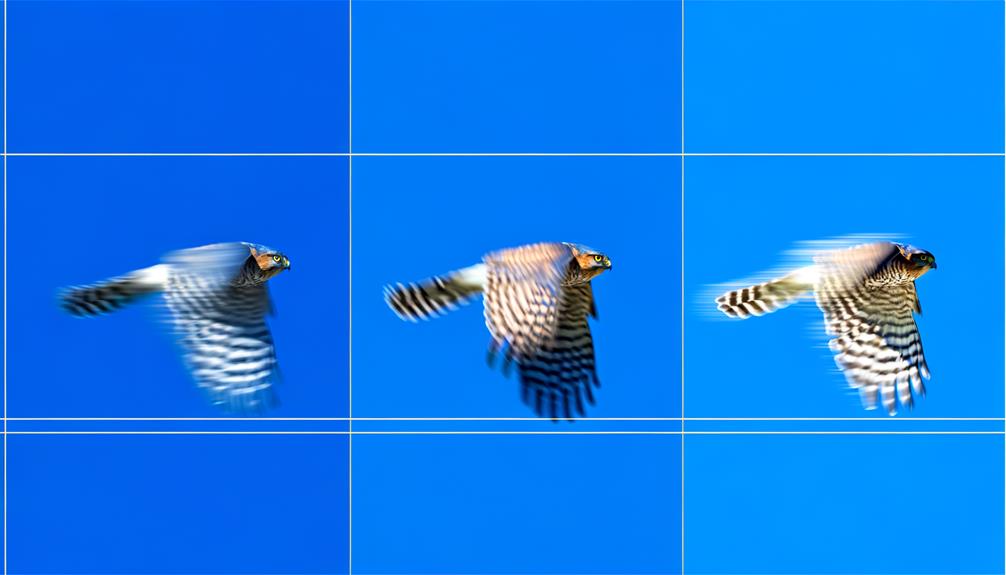
Juvenile sparrow hawks exhibit lower flight speeds compared to their adult counterparts due to undeveloped flight muscles and less refined hunting techniques. As these raptors mature, their flight capabilities improve significantly, allowing them to reach higher velocities essential for efficient predation.
Studies have shown that adults can achieve speeds of up to 50 km/h in level flight, which is critical for intercepting agile prey.
Key factors influencing speed development include:
- Muscular development: Enhanced muscle strength and endurance.
- Hunting proficiency: Improved techniques and experience.
- Aerobic capacity: Greater oxygen uptake and utilization.
- Feather condition: Optimal feather arrangement and maintenance.
- Environmental interactions: Adaptation to varying wind currents and thermals.
These elements collectively enable adult sparrow hawks to maximize their flight speed and hunting success.
Aerodynamics
The aerodynamics of a sparrow hawk's flight are largely governed by its wing shape, which enhances aerodynamic efficiency and facilitates rapid maneuverability.
The tapering and curvature of the wings optimize airflow, reducing drag and enabling higher speeds.
Empirical studies have demonstrated that these morphological characteristics are essential in achieving the bird's remarkable agility and velocity.
Wing Shape Efficiency
Often characterized by their slender and pointed wings, sparrow hawks demonstrate exceptional aerodynamic efficiency, allowing for rapid acceleration and agile maneuverability during flight. This wing morphology optimizes the lift-to-drag ratio, enhancing the bird's flight performance.
The following aspects highlight the efficiency of their wing design:
- Aspect Ratio: High aspect ratio wings reduce induced drag, facilitating sustained high-speed flight.
- Camber: Moderate wing camber aids in efficient lift production without incurring excessive drag.
- Wing Loading: Low wing loading contributes to superior maneuverability, essential for hunting.
- Wingtip Vortices: Reduced wingtip vortices minimize energy loss, conserving energy during prolonged flights.
- Feather Structure: Overlapping feathers streamline airflow, reducing turbulence and drag.
These features collectively enable sparrow hawks to excel in both speed and agility.
Airflow and Speed
Frequently, the precise control of airflow over the sparrow hawk's wings and body is crucial for achieving its remarkable flight speeds and aerodynamic efficiency.
This avian predator's wing morphology is tailored to manipulate airflow, reducing drag and maximizing lift. The tapered wingtips and smooth feather alignment facilitate laminar flow, minimizing turbulence.
Moreover, the hawk's ability to adjust its wing angle and shape dynamically allows it to exploit varying air currents and maintain the best speed.
Empirical studies using high-speed cameras and wind tunnel experiments have quantified this adaptability, demonstrating that the sparrow hawk can reach speeds up to 50 km/h during level flight and exceed 100 km/h in hunting dives, underscoring the critical role of aerodynamic principles.
Speed Measurement
Accurate speed measurement of a sparrow hawk in flight requires sophisticated techniques such as high-speed photography and radar tracking. These methods provide precise data on the bird's velocity, overcoming the limitations of visual estimation.
High-speed cameras capture rapid wing movements and flight patterns in fine detail. Radar tracking, on the other hand, offers real-time speed data over considerable distances.
Key methodologies include:
- High-speed photography: Captures minute-by-minute wingbeats.
- Radar tracking: Monitors speed over long distances.
- GPS telemetry: Provides continuous location and speed data.
- Laser range finders: Measure speed by detecting changes in distance.
- Doppler radar: Utilizes the Doppler effect to ascertain velocity.
These techniques assure reliable, accurate measurements crucial for understanding sparrow hawk flight dynamics.
Myths and Facts
The flight capabilities of the sparrow hawk have been shrouded in various myths, necessitating a distinction between anecdotal beliefs and scientifically verified facts.
Common folklore suggests these raptors achieve speeds exceeding 120 mph, comparable to peregrine falcons. However, empirical research indicates otherwise. Studies reveal that sparrow hawks (Accipiter nisus) typically reach speeds of 20-30 mph during level flight, with bursts up to 50 mph when diving for prey.
This discrepancy underscores the importance of evidence-based observations over anecdotal accounts. Modern tracking technology, such as GPS telemetry, provides accurate data on their flight dynamics, dispelling exaggerated claims.
Conclusion
Coincidentally, the intricate balance of aerodynamics and physiology allows the sparrow hawk to attain remarkable speeds, essential for its predatory success. The interplay of its streamlined body, rapid wingbeats, and acute visual acuity positions it among nature's most efficient aerial hunters.
Through scientific measurement, it is evident that age, environmental conditions, and evolutionary adaptations collectively influence its flight velocity. Dispelling myths, empirical data underscores the sparrow hawk's evolutionary prowess, showcasing nature's intricate design and the species' unparalleled flight capabilities.


